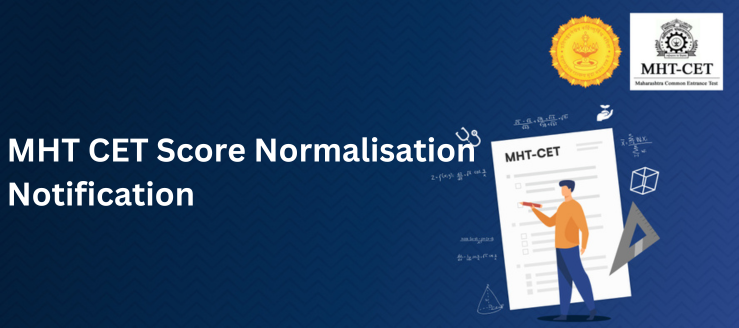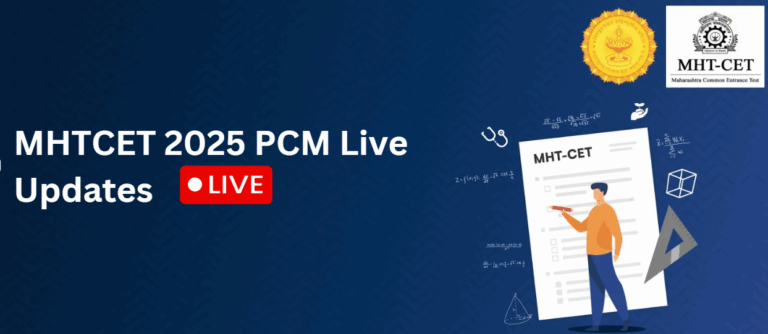
MHT CET Score Normalisation 2025: The Maharastra State Entrance Cell has released the normalization process. The MHT CET is conducted in multiple shifts across all test centers. This evaluation process is implemented to know the paper difficulty level between each shift. Candidates should note that, if they have appeared for both PCM and PCB, the percentile scores of Physics & Chemistry are not interchanged among the groups. The MHT CET Marks vs Percentile will be released after the declaration of results, by state cell of Maharastra.
The PCM exams are scheduled for April 19th, 2025 to April 27th 2025. The PCB exams will be completed on April 27th, 2025.
Candidates can expect the official answer key by June 2025. To be updated with latest information, candidates can check updates from here as well as official website.
Also Read: MHT CET Answer Key 2025
How MHT CET scores are transformed into percentiles?
The process transforms raw scores into Percentile Scores, ranging from 100 to 0, for each session of examinees. Here’s how it works:
Percentile Scores indicate the percentage of candidates scoring equal to or below a particular percentile in the examination. The highest scorer in each session receives a percentile of 100, ensuring parity among toppers. Scores between the highest and lowest are appropriately converted to percentiles. This approach replaces raw marks with normalised scores, mitigating the impact of varying difficulty levels.
To avoid clustering effects and tie-breakers, percentile scores are calculated up to 7 decimal places, ensuring precise rankings.
MHT CET Result Processing Methodology 2025
Candidates can understand how to calculate the MHT CET result by following the steps below:
Step 1: Candidates are randomly allocated to four sessions spread across two days and two shifts a day. This ensures unbiased distribution and minimizes the possibility of partiality. The four sessions would be as follows:
| Sessions | Days with Batches |
| Session-1 | Day-1 Batch 1 |
| Session-2 | Day-1 Batch 2 |
| Session-3 | Day-2 Batch 1 |
| Session- 4 | Day-2 Batch 2 |
Step 2: Results for each session are calculated, including raw scores and percentile scores for Mathematics, Physics, Chemistry, and the Total scores of candidates appeared in the session. These scores form the foundation for further normalization.
Step 3: Percentile scores from all sessions are merged to form the CET scores, used for result compilation.
Here is a PDF format of the normalization process for candidates’ reference:
| MHT CET Score Normalization | Click Here to Download |
Also Checkout: MHT CET College Predictor
Frequently Asked Questions
1. Why is Normalization necessary in MHT CET exams?
Normalization is necessary to address the inherent differences in question difficulty between shifts, ensuring equity in the evaluation process.
2. How does Normalization work in MHT CET exams?
Normalization aligns candidate scores across different test sessions by transforming raw scores into Percentile Scores. This ensures that candidates are neither advantaged nor disadvantaged due to variations in question paper difficulty.
3. What are Percentile Scores, and how do they ensure equivalence?
Percentile Scores indicate the percentage of candidates scoring equal to or below a particular percentile in the examination. The highest score in each session receives a percentile of 100, ensuring parity among toppers.
4. How are Percentile Scores calculated in MHT CET exams?
Percentile scores are calculated up to 7 decimal places to avoid clustering effects and tie-breakers, ensuring precise rankings.
5. What is the process for Normalization in MHT CET exams?
The process involves distributing examinees randomly across sessions, preparing results for each session including raw and percentile scores, and then compiling total CET scores by merging percentile scores from all sessions.
6. Can you provide an example of Normalization in MHT CET exams?
Certainly, In a hypothetical scenario with four sessions of examinees, the highest raw score in each session receives a percentile of 100, while the lowest raw score’s percentile depends on the total number of candidates in that session.







